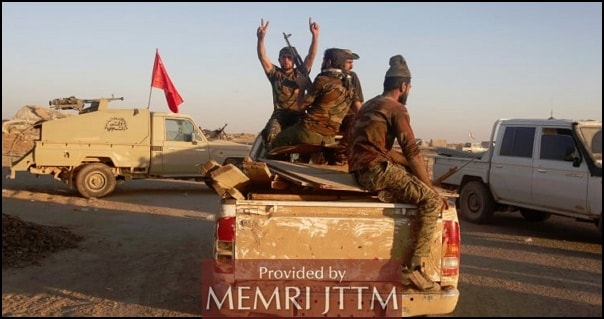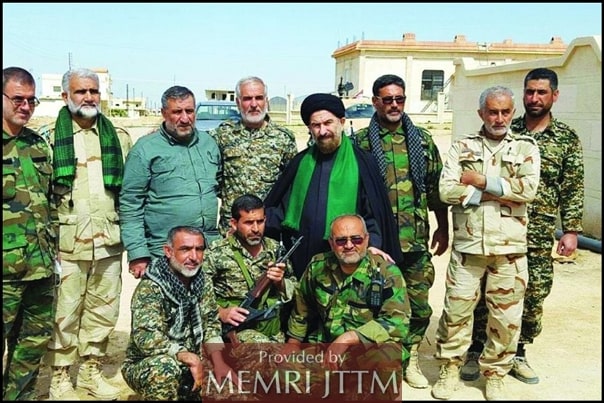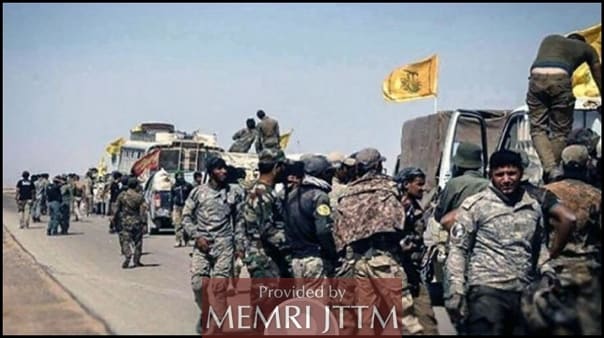The following report is now a complimentary offering from MEMRI's Jihad and Terrorism Threat Monitor (JTTM). For JTTM subscription information, click here.
On October 9, 2023, several Arab media oulets, among them those affiliated with the Syrian opposition, reported on a heightened level of preparedness on the part of Hizbullah and the Iran-backed militias in Syria in the event that the fighting between Israel and the Palestinian factions in the Gaza Strip reaches the Syrian arena. It has also been reported that the same organizations are readying themselves for the possibility of an Israeli attack on Syrian territory and so are reinforcing their troops in the south of the country, especially in the Daraa and Quneitra governorates in southwest Syria, which are adjacent to the border with Israel.
The following are excerpts from reports about the bolstering of forces in Syria that have appeared on Arab social media:
On October 9, 2023, the Syrian opposition website, Damascus Voice, which reports on the Damascus region, shared an “exclusive” report which states that, “during the previous hours,” several squads of Hizbullah’s elite Radwan Unit arrived at a military base near the village of Al-Sihayliyyah, north of Daraa, equipped with anti-tank missiles and Iran-made Ababil drones that. The website also stated that the Imam Al-Hussayn Brigade militia transported 60 of its operatives, with mortars, rocket launchers, and anti-tank missiles from the area near Damascus to Tel Al-Za’tar near Daraa, where they reinforced tunnels and fortifications and deployed light and heavy machineguns. The website further reported that during the past two weeks Hizbullah started to build an airstrip for military drones at the Syrian aerial defense Brigade 82 base located near the town of Sheikh Miskin, north of Daraa. At the same time, Hizbullah was building fortifications and redeploying forces along the border with Israel, “in advance of an imminent confrontation.” While preparing the airfield, Hizbullah also transferred a number of drones from military bases near Damascus to the Brigade 82 base.[1]

Also on October 9, the Syrian opposition-affiliated Syrian Observatory for Human Rights (SOHR), reported on increased activity of the Iran-backed militias adjacent to the Syria-Lebanon border and the border with “the occupied Golan” and also in Damascus and in the Quneitra area.
The Damascus Voice website further reported that Hizbullah and “the Syrian resistance to liberate the Golan,” have put their Syrian and Lebanese operatives in these areas on full alert, brought in military and logistic reinforcements, carried out fortification work, moved weapons to secured areas and made preparations in the event of an Israeli attack in the framework of the recent events in “the occupied Palestinian territories.”[2]

The London-based Saudi-funded Al-Sharq Al-Awsat daily reported that the Syrian regime forces, Hizbullah, and the militias subordinate to the Iranian Islamic Revolutionary Guard Corps (IRGC) on the southern front near the Syrian border with the “occupied Golan,” were put on alert for fear of an Israeli attack. For the same reason, Hizbullah and the Iran-backed militias changed the deployment of their forces, and moved weapons and military equipment from their storage facilities to different locations. This movement occurred mainly in the Damascus and Quneitra areas, and on the frontline with Israel. The daily added that “local sources” revealed that Hizbullah and the IRGC moved weapons and military equipment from storage facilities near Damascus and the Damascus International Airport to the front in the south.
Al-Sharq Al-Awsat further reported that according to “security sources,” on October 8, Hizbullah special units deployed along the Syria-Israel border and that an officer named Hajj Muhammad Assad Allah who heads an IRGC force in the Damascus area, arrived with the force at the Quneitra Governorate to supervise the transfer of drones from IRGC bases in Daraa Governorate to locations adjacent to the Golan Heights and the border with Israel.[3]

A Telegram channel which covers the Deir Al-Zour region in northeastern Syria, posted an “exclusive” report according to which the IRGC Command in Deir Al-Zour Governorate informed several of its senior officials about its intention of sending several IRGC members to Quneitra Governorate. The channel noted that during the recent fighting between Gaza and Israel, IRGC commanders received direct orders from Iran to transfer some of their members from Deir Al-Zour to Quneitra. It also stated that since the Israeli attack on the Deir Al-Zour Governorate “ten days ago,” as well as following recent events in the area of the Gaza Strip, the Iran-backed militias in Deir Al-Zour have been on alert.[4]

It is noteworthy that since the start of the fighting, various Iran-backed Shi'ite groups in Lebanon, Iraq, Yemen, and Bahrain have vowed to support Hamas and the Palestinian factions which have joined the fighting against Israel, and have even expressed willingness to take an active part in the fighting.[5]
[1] October 9, 2023.
[2] October 9, 2023.
[3] October 9, 2023.
[4] October 9, 2023.
[5] See MEMRI JTTM Reports: Iran-Backed Militia In Bahrain Saraya Wa'ad Allah Celebrates Hamas Attack On Israel, Calls For Action Against 'Zionists' In Bahrain, October 9, 2023; Iran-Backed Militia Unit Listed Under Iraqi Government-Sponsored Popular Mobilization Units (PMU) Releases Video Message Extending Support To Hamas In Attack Against Israel, October 9, 2023; Iran-Backed Militias In Lebanon, Iraq, And Yemen Release Statements On Telegram In Support Of Hamas Attack – Lebanese Hizbullah: 'Rifle Of Resistance Is The Only Option In Confronting The Occupation'; Yemen's Ansar Allah Houthi Movement: 'Yemeni People Are Ready To Participate In Operation', October 7, 2023; Leaders Of Iran-Backed Militias In Iraq Vow Support To Palestinian Factions In Hamas Attack, Threaten To Respond To Any Israeli Or American Attack Against Them, October 7, 2023; and Political Leader Of Ansar Allah Houthi Movement Delivers Remarks At Rally In Sana'a, Yemen, In Support Of Hamas Attack, Addresses Israel: 'Today We Saw Your Trained Soldiers Kneel', October 7, 2023.
The full text of this post is available to subscribers.
Please login or register to request subscription information from MEMRI




